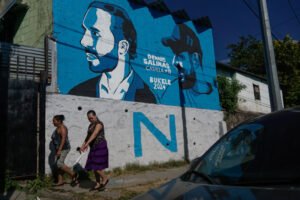This past Tuesday, March 19, I was in Guatemala for the start of the trial of General Efraín Ríos Montt, the former Guatemalan dictator accused of genocide and crimes against humanity committed during his 1982-1983 regime. The trial won’t conclude quickly (delay seems to be part of the defense strategy), so although we won’t know the final outcome for a while, it was a privilege to be there for the opening of the trial. That General Ríos Montt has to appear before a court of law, and face his accusers is an important victory for victims and their families, who have waited 30 years for justice.
According to the final report of Guatemala’s Historical Clarification Commission, the internal armed conflict that took place in Guatemala left 200,000 dead and between 40,000 and 50,000 missing. Ríos Montt’s 17 months in power, which included a scorched-earth campaign that resulted in the deaths of thousands of people, were among the most violent of the 36-year war. Among other charges, Ríos Montt is in court this week accused of orchestrating the massacre of more than 1,750 indigenous Ixil Mayans in the Guatemalan department of Quiché.
After more than three decades, finally Ríos Montt is being held accountable, and the scene outside the Supreme Court on Tuesday morning was dramatic. As hundreds of onlookers waited to enter the trial, a procession of witnesses and family members of the victims lined up and walked inside. Everyone applauded as the group—comprised of people wearing traditional indigenous dress, jeans and tee shirts, and everything in between—filed into the building. It was a powerful moment that symbolized one of the key things that this trial is about—affirming that justice can finally be done in Guatemala on behalf of indigenous people and ordinary citizens who have suffered injustice at the hands of the military and the elite.
Inside the courtroom, I was struck by the variety of legal maneuvers and delaying tactics used by Ríos Montt’s legal team, as has been reported in detail by the Open Society Foundation’s Justice Initiative. In what was clearly a calculated attempt to delay proceedings, Ríos Montt brought on a new attorney the morning of the trial, who then attempted to force the chief justice out of the case, which would have forced the court to start again and select a new panel of judges. Interestingly, the three judge panel ruled that the attorney in question should withdraw from the case rather than have the judge recuse herself, and the trial proceeded as planned.
Most powerful of all, perhaps, were the opening statements by the prosecution and the defense. The prosecution argued that Ríos Montt was responsible for a counter insurgency campaign whose goal was the destruction of the Maya Ixil as a distinct ethnic group through a strategy that sought to kill civilians, force them out of their communities, and move them to refugee camps where their distinct ethnic identity would be wiped out.
The defense countered with a legal argument, saying that there is no proof that Ríos Montt authorized genocide and pointing out that his major campaigns—Plan Victoria and Operation Sofia—included orders to respect human rights. It concluded with an unrepentant speech that appealed to right wing nationalism. He attacked the “foreigners” who were behind the charges against Ríos Montt; the comment was a clear reference to the international observers present in the courtroom, among others.
The trial of General Efraín Ríos Montt is a historic step forward for justice and the rule of law in Guatemala. Ríos Montt is the first former president to be tried for genocide in Latin America; so far, the trial suggests that Guatemala is taking seriously its obligation to prosecute and punish those who commit crimes against humanity. This will be the true foundation for a more just, secure, and peaceful Guatemala.

